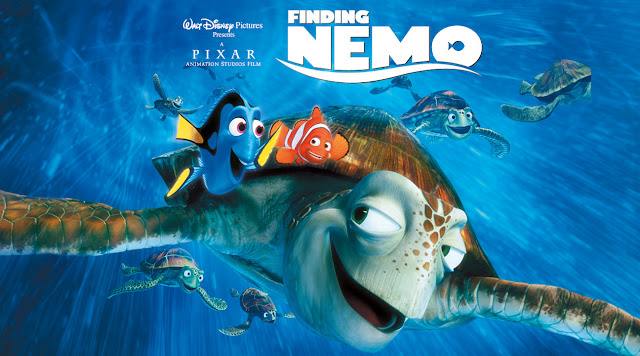After his son is captured in the Great Barrier Reef
and taken to Sydney, a timid clownfish sets out on a journey to bring him home.
Directors: Andrew Stanton, Lee Unkrich
Writers: Andrew Stanton (original story by), Andrew
Stanton (screenplay)
Stars: Albert Brooks, Ellen DeGeneres, Alexander Gould.
Storyline
A clown fish named Marlin lives in the Great Barrier
Reef loses his son, Nemo. After he ventures into the open sea, despite his
father's constant warnings about many of the ocean's dangers. Nemo is abducted
by a boat and netted up and sent to a dentist's office in Sydney. So, while
Marlin ventures off to try to retrieve Nemo, Marlin meets a fish named Dory, a
blue tang suffering from short-term memory loss. The companions travel a great
distance, encountering various dangerous sea creatures such as sharks,
anglerfish and jellyfish, in order to rescue Nemo from the dentist's office,
which is situated by Sydney Harbor. While the two are doing this, Nemo and the
other sea animals in the dentist's fish tank plot a way to return to Sydney
Harbor to live their lives free again.
User
Reviews
Pixar's best feature to date
15 October 2005 | by kylopod (kylopod@aol.com)
(Baltimore, MD) – See all my reviews
I have enjoyed most of the computer-animated films
made so far, ranging from Pixar films like "Toy Story" and "The
Incredibles" to DreamWorks films like "Shrek." But "Finding
Nemo" is the one that remains unparalleled, not because of its comedy or
creativity, both of which are equaled in the "Toy Story" movies and
in "Monsters Inc.," but because it truly, more than any of the
previous computer-animated features, reinvents the genre of the children's
animated film.
Humor in traditional animation is usually based on
broad slapstick and physical exaggeration. There are occasional nods to this
brand of humor in "Finding Nemo," as when a flock of seagulls ram
into a boat and we see their beaks crowing on the other side of the sail. But
such sequences only call attention to how far this movie generally departs from
old cartoon conventions. Instead, the movie invests its world of sentient
animals with a surprisingly scientific texture. All of the animals are based on
real species. The fish tank is constructed out of real devices. There is a
strong sense of locale, as Marlin (Albert Brooks) travels across the Pacific to
Australia, where even the animals speak with an Australian accent. In a scene
that I'm sure Gary Larson of "Far Side" fame loved, a pelican
discusses with a group of fish the intricate details of dentistry. The fact
that the animals talk and understand what's going on is treated as though it
were a natural feature of the world. The realism is so striking that by the end
of the film, you'll almost believe it possible for fish to plot an escape from
a tank.
Far from making the film pedantic, this approach
results in an intelligent but still entertaining picture. Most of the humor is
based on parodies of human behavior: repentant sharks start a club that's like
Alcoholics Anonymous, a school of fish act like obnoxious DJs while forming
themselves into spectacular patterns, and a four-year-old girl behaves like
most kids that age, oblivious and destructive. The manner in which Marlin finds
his way to his son is so inventive that we can forgive the film for the number
of coincidences involved.
The story employs the same basic formula used in
"Toy Story," in which two characters, one uptight and the other
clueless, are thrown together as they're forced to journey through a world
populated by creatures that are a lot more knowing than the humans realize.
This movie, however, creates a unique character in Dory (Ellen DeGeneres), a
fish with short-term memory loss. To give a cartoon character a real human
disorder is risky, to say the least, and I'm glad the filmmakers didn't lose
the nerve to include this ingenious device, which not only generates some of
the film's biggest laughs, but reinforces the character interaction that is so
central to the story. This is in fact the only Pixar film to feature true
character development. In the course of his voyage, Marlin learns to be more
adventurous, getting parenting tips from a surfer-dude turtle voiced by the
film's director Andrew Stanton, while his son Nemo learns to be self-reliant.
Of course, none of the sharks, jellyfish, whales,
gulls, pelicans, lobsters, and humans that Marlin encounters along the way
really mean any harm. They're just doing what they do. As Nigel the Pelican
tells Nemo at one point, "Fish gotta swim, birds gotta eat." That's
perhaps the film's most interesting insight, that there are no true villains,
just creatures that act according to their nature, and a few that transcend it.











